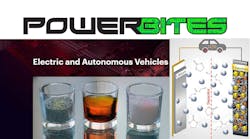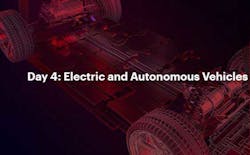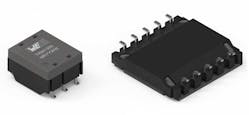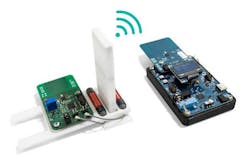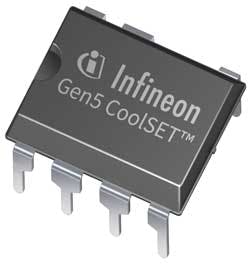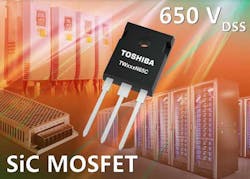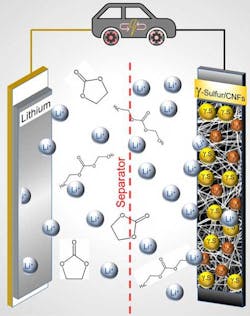This article is part of the This Week in PowerBites Library Series.
Online Symposium Explores the Promises and Challenges of the EV Revolution
Keysight's four-day online vision conference will give designers an opportunity to dive into some of the electric-vehicle (EV) industry's most significant technology trends and challenges. EVs are one of four themes that will be covered in online sessions to be held in regions around the world throughout October, November, and December 2022.
Titled "Accelerating the Automotive Revolution,” this 100-minute session examines the challenges to wide-scale adoption that still lie ahead and explores what the next decade will hold as the industry progresses down the path to full vehicle autonomy. It’s intended to give designers and technology managers a head start on near- and far-term technology developments. You'll have the opportunity to hear industry leaders and futurists share their expertise and predictions.
The session will kick off with a keynote from Tesla's Javier Verdura, who discusses the power of design and how the lessons Tesla learned are influencing legacy automakers to adopt EVs as a roadmap for future growth. This will be followed by the roundtable "One Power, Many Standards." Industry notables, including Tom Cheesewright from Applied Futurist, will discuss the EV revolution, from battery technology to charging infrastructure, and what technological advances are really needed to bring it over the finish line.
Finally, Chris Gerdes, Center for Automotive Research at Stanford (CARS), will take you to the racetrack to map out the future of safe autonomous vehicles.
The conference's other sessions will cover 5G and 6G, quantum computing, digital twins, and artificial intelligence.
Separate time- and language-appropriate conference sessions will be held for North America, Europe/The Middle East/Africa/India, Southeast Asia Pacific, Japan, Korea, Shanghai, and Taipei throughout November and December. Click here for details and registration.
ASIL C-Certified Battery-Management System Takes on High-Voltage Applications
Sensata Technologies' Lithium Balance n3-BMS is an ISO 26262-certified battery-management system (BMS) capable of supporting loads of up to 1,000 V/2,000 A in applications that include electric trucks, buses, and other heavy commercial vehicles.
This off-the-shelf, cell-chemistry-agnostic distributed BMS consists of a master control unit and up to 30 cell monitoring units. Thanks to its ASIL C compliance and ISO 26262 pre-certification, designers can dramatically reduce the time-to-market and costs associated with the certification process.
Even though the n3-BMS is a certified product, the n3-BMS maintains software flexibility by using a unique software structure that allows users to adjust key BMS parameters and even include their own code and algorithms without any risk on the ISO 26262 certification.
The BMS software architecture consists of a “Base Software Layer” (BSW) and an “External Software Layer” (ESW) that are connected by an open API link layer. Since all of the BMS’s safety-critical functionalities are in the BSW layer of the software, developers are free to implement their own software code and algorithms in the ESW also without any risk to the ISO 26262 certification of the system.
Additional key features of the n3-BMS include support for 24 to 360 cells in series and three ASIL C-compliant CAN ports.
For developers currently working on next-generation, heavy electric vehicles that expect the need for an ISO 26262-certified system in the future, this provides a convenient and cost-effective pathway to achieve an ASIL C-certified BMS with a simple upgrade (available early 2023).
For additional information about Sensata's Lithium Balance n3-bms, which will be available in early 2023, visit www2.sensata.com/n3-bms.
Compact Galvanic-Isolation Solutions for Reliable BMS
Würth Elektronik's new WE-BMS series of battery-management components includes galvanically isolated signal transformers intended for use in energy-storage systems, uninterruptible power supplies, e-bikes, or e-scooters. They provide galvanic isolation of 4300 VDC/1 min and high operating voltage of up to 1000 VDC.
In addition, the WE-BMS series includes common-mode chokes to filter common-mode interference. Beyond their compact form factor, the unique design offers significantly less physical creepage than comparable products. They’re also available in low-profile component variants that are only 3.45 mm high.
This family of transformers is optimized to ensure reliable operation and accurate sensing of charging status in battery-management systems. Their primary function is to isolate components from each other and suppress EMI caused by voltage differences and other sources of electromagnetic interference that may occur between series-connected components or boards. WE-BMS supports serial daisy chain, isoSPI, and SPI.
Designed for the extended operating temperature range between −40 and 125°C, the component is available from stock in various sizes from 7.6 × 9.5 × 5.5 mm to 15.1 × 15.4 × 3.45 mm with no minimum order quantity. Würth Elektronik provides free samples for engineers.
Energy Harvester Uses Wiegand Technology to Power the IoT
A research team at FRABA’s R&D center in Aachen, Germany has demonstrated a prototype of a wireless sensor powered by Wiegand technology, intended to power devices attached to the Internet of Things (IoT) network. The principles demonstrated by the prototype will be the basis of a new class of commercially available energy-harvesting devices produced by UBITO, a member of the FRABA family of technology companies.
Wiegand technology, which collects energy from movements of an external magnetic field, has previously been used in commercial applications that require extremely small amounts of power, such as detecting and recording rotations in flow meters and multi-turn encoders. FRABA's research has resulted in an improved harvester that can generate over 50X more energy than existing devices, enough to power the sensor’s electronics package, including a high-efficiency ultra-wideband (UWB) radio transmitter.
The team used a window sensor system for a practical demonstration of an IoT sensor node powered by Wiegand-harvested energy. Two Wiegand harvesters and their associated electronics were mounted on the window, with bar magnets mounted on the frame. The harvesters, made up of 21-mm-long pieces of Wiegand wire surrounded by a copper coil, are the size of an AAA battery (d=7.5 mm).
Whenever the window is opened or closed, the harvesters pass the magnets, triggering abrupt magnetic polarity changes in the Wiegand wires. The amount of energy delivered is largely independent of how quickly or slowly the window is moved—a key benefit of Wiegand technology.
The harvester generates roughly 10 µJ of energy, sufficient to activate a microcontroller and collect a reading from a temperature sensor built into the system. The UWB transmitter module cab transmit 134 bytes of data to a receiving station 60 m away.
“This is a lab demonstration, not a commercial product" said Tobias Best, global head of the UBITO startup. "However, by showing the capabilities of a system made up of Wiegand devices and off-the-shelf electronic components, we hope to spark interest in the wonderful potential for this technology.”
Space-Saving 800/950-V AC-DC Integrated Power Stages Cut Costs, Speed Designs
Infineon added several new 800- and 950-V ac-dc integrated power-stage (IPS) devices to its portfolio of fifth-generation fixed-frequency (FF) CoolSET devices. Designed to deliver the performance, efficiency, and reliability required by modern high-voltage power supplies, CoolSET modules integrate a pulse-width-modulation (PWM) controller IC and superjunction (SJ) high-voltage MOSFETs in a single package to simplify the design of SMPS products while reducing their BOM and manufacturing costs.
Housed in a DIP-7 package, the modules address applications such as auxiliary power supplies for home appliances, ac-dc converters, battery chargers, solar-energy systems, and motor control and drives.
All CoolSET devices support both isolated and non-isolated topologies such as flyback or buck and operate at switching frequencies of 100 kHz as well as 65 kHz. Accommodating both the cost-efficient buck topology and flyback in one single device helps simplify the supply chain for customers. An integrated error amplifier supports direct feedback from the primary output, which is typical for non-isolated topologies.
CoolSET controllers support a frequency-reduction mode with soft gate driving and frequency jitter operation that lowers EMI and enhances efficiency between mid- and light-load conditions. The devices also support continuous (CCM) and discontinuous conduction mode (DCM). For low ac-line input conditions, CCM operation can achieve lower conduction losses for higher efficiency, enabling the products they power to meet international regulatory eco-standards. In addition, the active burst mode (ABM) improves light-load performance and allows for ultra-low standby power consumption.
All new devices offer a comprehensive suite of protection features, as well as auto-restart to support the power-supply system in failure situations.
The new fixed-frequency 800 V and 950 V CoolSET fifth-generation product portfolio of ac-dc IPS is available now in a DIP-7 package. More information is available at www.infineon.com/coolset-ff.
Third-Gen 650/1,200-V SiC MOSFETs Augment Efficiency and Reliability
Toshiba Electronics recently launched five new 650-V and five 1200-V silicon-carbide (SiC) MOSFET devices:
- The 650-V devices target a variety of demanding applications, including switch-mode power supplies (SMPS) and uninterruptible power supplies (UPS). They also will find applications in renewable energy, including photovoltaic (PV) inverters and bidirectional dc-dc converters, such as those used for electric-vehicle (EV) charging.
- The 1,200-V devices are intended to boost the energy efficiency of high-voltage industrial applications such as EV charging stations, photovoltaic inverters, industrial power supplies, UPS, and bidirectional or half-bridge dc-dc converters.
Both series are based on Toshiba’s advanced third-generation SiC process that optimizes the cell structures used in second-generation devices to dramatically reduce losses. By improving the on-resistance × gate-drain charge (RDS(on) × QGD) figure of merit by more than 80%, the company’s technology elevates both conduction and switching performance in power-conversion topologies.
In common with earlier devices, the new MOSFETs include a built-in SiC Schottky barrier with a low forward voltage (VF) of −1.35 V (typ.) to suppress fluctuation in RDS(on), thereby enhancing reliability. Together, these improvements ensure predictable switching performance with minimal drift as well as simplify gate-driver designs.
The 600-V devices (TW015N65C, TW027N65C, TW048N65C, TW083N65C, and TW107N65C) are able to handle currents (ID) up to 100 A and feature RDS(on) values as low as 15 mΩ. All devices, housed in a standard TO-247 package, are in full production.
The new series of 1,200-V SiC MOSFETs includes the TW015N120C, TW030N120C, TW045N120C, TW060N120C, and TW140N120C. All of these devices have a generous maximum gate-source voltage range (−10 to 25 V), which enhances flexibility to operate in various circuit designs and application conditions. They have a wide gate-threshold voltage (VGS(th)) range (3.0 to 5.0 V), RDS(on) values ranging from 15 to 140 mΩ (typical, at VGS = 18V ) and drain-current ratings from 20 to 100 A (dc at TC = 25°C).
Sulfur-Based Battery Chemistries Show Promise as Low-Cost Alternatives to Lithium Cells
Researchers at MIT, Drexel, and elsewhere are developing new battery chemistries based on sulfur and other abundant, inexpensive materials that could dramatically reduce the cost of energy storage for utilities and other applications. If they can be scaled to commercial production, these alternative batteries may help prevent the cost of energy storage from becoming a major speed bump in the road to a sustainable economy. The two technologies discussed in this article are a small sampling of the emerging solutions for different sectors of the energy storage market.
MIT's Lithium-Aluminum Cell
The high cost of lithium-based batteries is slowing the adoption of electric vehicles. Meanwhile, the utility sector faces even bigger challenges as it struggles to find cost-effective grid-scale storage systems to support their rapidly growing wind and solar assets.
To address those issues, a team from MIT, in collaboration with researchers from China, Canada, and the U.S. (Kentucky and Tennessee), have developed a lithium-free battery architecture that uses aluminum and sulfur as its two electrode materials, with a molten salt electrolyte in between.1 Details of the architecture are described in the journal Nature, in a paper by MIT Professor Donald Sadoway.2
In his search for a safer, lower-cost battery, Sadoway and his team selected aluminum and sulfur as the materials for the new cell's electrodes. Simultaneously, his team was investigating alternative electrolytes that didn't have the volatile, flammable, and corrosive properties of the organic liquids, commonly used in most lithium-ion batteries. Eventually they focused on a family of chloro-aluminate molten salts that have relatively low melting points (e.g., close to the boiling point of water vs. nearly 1,000°F for many salts).
Prototype battery cells made from those three ingredients demonstrate very high power densities and a projected cost per cell of about one-sixth that of comparable lithium-ion cells. They’re also able to endure hundreds of cycles at exceptionally high charging rates. Their long life is due in good part to the battery's electrolyte, suppressing the formation of metallic dendrites that can create micro-short circuits, which will reduce a battery's capacity and eventually kill it completely.
Sadoway says that this new battery formulation would be ideal for installations requiring a few tens of kilowatt-hours of storage capacity, such as home power walls, small to medium business, or EV charging stations. For larger installations, (tens to hundreds of megawatt-hours), other technologies might be more effective, including the liquid-metal batteries Sadoway and his students developed several years ago via a spinoff company called Ambri, which hopes to deliver its first products within the next year.
Drexel's Lithium-Sulfur Cell
Another promising sulfur-based battery architecture is under development at Drexel’s College of Engineering. Although its chemistry does include lithium, it requires a small fraction of the amount per kilowatt-hour used by conventional batteries and eliminates the need for other scarce materials altogether. Their work, published in the journal Communications Chemistry,3 appears to offer a way to sidestep the obstacles that have plagued lithium-sulfur (Li-S) batteries in the past.
One of the most common problems faced by earlier Li-S battery architectures was irreversible chemical reactions between intermediate sulfur products that would cause nearly immediate shutdown and/or a complete failure after just one charge/discharge cycle.
Researchers were able to overcome this with ether-based electrolytes (polysulfides vs. carbonates), which demonstrated exceptional performance in carefully controlled lab environments but were poorly suited for real-world conditions. The electrolytes' extremely low boiling points (as low as 42°C) meant that the battery had to be cooled below room temperature at all times to avoid a failure or meltdown.
Drexel's battery solves this problem by using electrodes made from a unique form of sulfur. It’s much less reactive with carbonate-based electrolytes that have much higher boiling points. Until the team discovered a method for producing and stabilizing the electrode's complex crystalline structure in commercial volumes, it had only been synthesized in labs at high temperatures or observed in nature in the extreme pressures and temperatures found in oil wells.
Drexel's sulfur cathode breakthrough could pave the way for better-performing and sustainably sourced batteries for EVs, computers, and mobile devices. After more than a year of testing, the sulfur cathode remains stable and, as the team reported, its performance hasn’t degraded in 4,000 charge-discharge cycles—a substantial improvement over the 500-1,000 cycles typically enjoyed by most lithium cells. And, as predicted, the battery's capacity is more than threefold that of a Li-ion battery.
An upcoming feature article will provide additional details on these breakthroughs, as well as news about another promising battery that uses crab shells as a primary component.
References
1. Pang, Q., Meng, J., Gupta, S. et al. “Fast-charging aluminium-chalcogen batteries resistant to dendritic shorting.” Nature 608, 704–711 (2022). https://doi.org/10.1038/s41586-022-04983-9
2. https://drexel.edu/news/archive/2022/february/lithium-sulfur-cathode-carbonate-electrolyte
3. Pai, R., Singh, A., Tang, M.H. et al. “Stabilization of gamma sulfur at room temperature to enable the use of carbonate electrolyte in Li-S batteries.” Commun Chem 5, 17 (2022). https://doi.org/10.1038/s42004-022-00626-2
Read more articles in the This Week in PowerBites Library Series.
